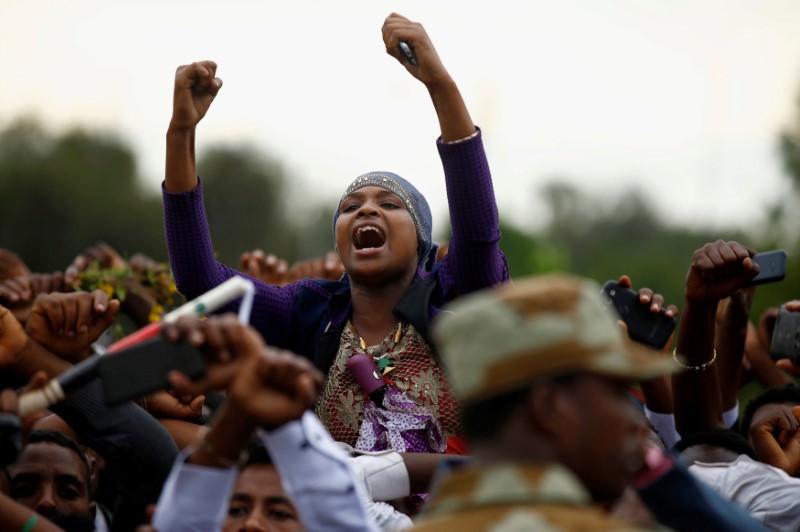
By Asad Hashim and Drazen Jorgic
ISLAMABAD (Reuters) – Pakistani opposition leader Imran Khan accused the government of placing him under virtual house arrest in Islamabad on Friday as his supporters in nearby Rawalpindi fought running battles with the police.
Police tear-gassed and baton-charged the rock-throwing protesters in Rawalpindi, 20 km (12 miles) from Islamabad, as both sides prepared for his plan to shut down the capital next week to try to force Prime Minister Nawaz Sharif to resign.
There was no immediate report of injuries and the violence eased as darkness fell, but a handful of protesters defying a ban on public gatherings continued to clash with police.
Police also fired tear gas and briefly clashed with protesters near Khan’s house in Islamabad.
The protests added to rising political tension ahead of Khan’s vow to lock down the capital on Wednesday to try to force Sharif to quit because of corruption allegations.
Sharif is also under pressure from his own camp, where relations between his ruling PML-N party and the powerful military have been strained by a newspaper leak about a security meeting that angered army officials.
Khan, a former cricket hero, told reporters outside his home that he had been placed “under almost house arrest” by scores of police officers stationed around his home in Islamabad.
He said he had canceled plans to attend a rally by a political ally in Rawalpindi and urged supporters to instead focus on the mass protests on Wednesday.
“To all my activists, you have to prepare for Nov. 2, you have to escape capture,” he said.
BAN ON GATHERINGS
Khan called for nationwide protests on Friday after 38 activists from his Pakistan Tehreek-e-Insaf (PTI) party were arrested a day earlier during a raid by baton-wielding police on an indoor youth rally in Islamabad.
Police said the rally contravened a city order issued hours earlier that banned all public gatherings in Islamabad and Rawalpindi ahead of next week’s protests.
Khan, who led a weeks-long occupation that paralyzed the government quarter of Islamabad in 2014 after rejecting Sharif’s decisive election win, has vowed to contest orders banning public gatherings in court.
Sheikh Rashid, a Khan ally from the Awami Muslim League (AML) party, went ahead with his rally in Rawalpindi on Friday.
TV footage showed the portly AML leader being ferried to the rally on the back of a motorbike through the side streets of Rawalpindi. He then climbed on top of a van, shook his fist in the air to supporters and dared police to arrest him.
Police said they did not have orders for his arrest.
Authorities blocked main roads leading to the Rawalpindi rally with shipping containers and obstructed the rally site with trucks and containers, keeping PTI supporters from gathering there en masse.
VOW TO SHUT SCHOOLS, AIRPORT
Islamabad Deputy Commissioner Mushtaq Ahmed said Khan’s party would need official permission, in the form of a so-called “No Objection Certificate” (NOC), to host any events, including Wednesday’s shutdown strike.
“You need an NOC for anything – whether it’s a media function or a marriage function. Even for a birthday party of more than five people, you need an NOC,” he told Reuters.
Khan has said next week’s protests would bring a million people onto the streets and sit-ins would force the closure of schools, public offices and the main international airport.
Khan’s latest challenge to Sharif’s government is based on leaked documents from the Panama-based Mossack Fonseca law firm that appear to show that his daughter and two sons owned offshore holding companies registered in the British Virgin Islands. Sharif’s family denies wrongdoing.
Holding offshore companies is not illegal in Pakistan, but Khan has implied the money was gained by corruption. He admitted in May that he used an offshore company himself to legally avoid paying British tax on a London property sale.
The ruling party has dismissed Khan’s shutdown plan as a desperate move by a politician whose popularity is waning ahead of the next general election, likely to be held in May 2018.
“Pakistan is going towards becoming a developed country, and the opposition is worried that if this system of development continues until 2018, then by then their politics will be finished,” Sharif told a gathering of party workers on Friday.
(Additional reporting by Kay Johnson; Writing by Drazen Jorgic; Editing by Tom Heneghan)












